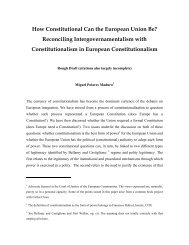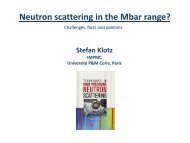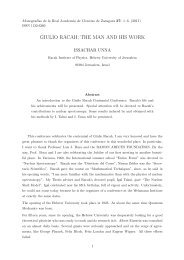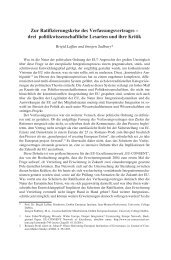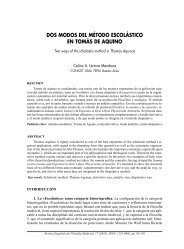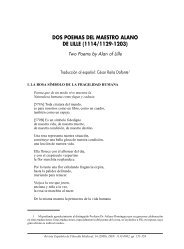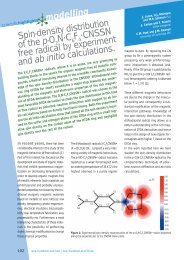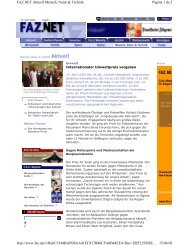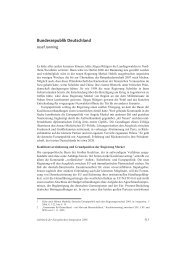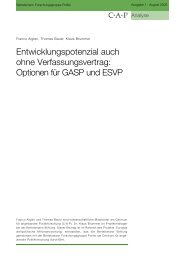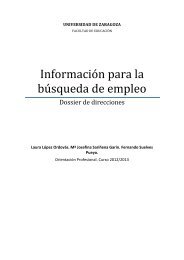Non-integrability of anisotropic quasi homogeneous Hamiltonian ...
Non-integrability of anisotropic quasi homogeneous Hamiltonian ...
Non-integrability of anisotropic quasi homogeneous Hamiltonian ...
You also want an ePaper? Increase the reach of your titles
YUMPU automatically turns print PDFs into web optimized ePapers that Google loves.
PRE-PUBLICACIONES del<br />
seminario matematico 2002<br />
<strong>Non</strong>-<strong>integrability</strong> <strong>of</strong> <strong>anisotropic</strong><br />
<strong>quasi</strong> <strong>homogeneous</strong><br />
<strong>Hamiltonian</strong> systems<br />
M. Arribas<br />
A. Elipe<br />
A. Riaguas<br />
“garcia de galdeano”<br />
n. 22<br />
seminario<br />
matemático<br />
garcía de galdeano<br />
Universidad de Zaragoza
<strong>Non</strong>-<strong>integrability</strong> <strong>of</strong> <strong>anisotropic</strong> <strong>quasi</strong><br />
<strong>homogeneous</strong> <strong>Hamiltonian</strong> systems<br />
M. Arribas a,b , A. Elipe a , A. Riaguas a,b<br />
a Grupo de Mecánica Espacial. Universidad de Zaragoza. 50009 Zaragoza. Spain<br />
b Dpto. Matemática Aplicada. Universidad de Zaragoza. 50009 Zaragoza. Spain<br />
Abstract<br />
We consider the <strong>anisotropic</strong> <strong>Hamiltonian</strong> systems which potential is made <strong>of</strong> a finite<br />
sum <strong>of</strong> <strong>homogeneous</strong> parts <strong>of</strong> arbitrary degree. For this problem, we prove for two<br />
and three degrees <strong>of</strong> freedom, that there are no more meromorphic integrals than<br />
the <strong>Hamiltonian</strong> itself, except for the classical integrable cases.<br />
Key words: <strong>Non</strong>-<strong>integrability</strong>; Anisotropic problem; Homogeneous potential<br />
1 Introduction<br />
Central force fields are among the first forces one meets in Mechanics. Indeed,<br />
they represent integrable systems, for they are systems <strong>of</strong> only one degree <strong>of</strong><br />
freedom, and besides, fundamental motions like the Keplerian one, harmonic<br />
oscillators and diffusors belong to this class <strong>of</strong> forces. More complex problems<br />
are represented by adding perturbations to these more simple problems above<br />
mentioned.<br />
One <strong>of</strong> the first central perturbation added to the Kepler problem was proposed<br />
by Newton in Liber II, Propositio XLIV <strong>of</strong> his Philosophiae Naturalis<br />
Principia Mathematica [15]. Indeed, a short sentence at the end <strong>of</strong> Corollarium<br />
2 <strong>of</strong> Propositio XLV reveals that Newton considered at one time explaining<br />
departures in the orbit <strong>of</strong> the moon from a mere Keplerian orbit as the effect<br />
<strong>of</strong> an additional central repulsion. Thus, the potential is <strong>of</strong> the type<br />
U(r) = − A r − B<br />
2r 2 , (1)<br />
where A and B are parameters, independent <strong>of</strong> the radial distance r. This potential<br />
represents the class <strong>of</strong> what Deprit [7] dubbed <strong>quasi</strong>-Keplerian systems.<br />
Preprint submitted to Elsevier Science 3 December 2002
Deprit obtained analytical solutions by means <strong>of</strong> a canonical transformation<br />
— the torsion— that converts the <strong>quasi</strong>-Keplerian <strong>Hamiltonian</strong> into a pure<br />
Keplerian one.<br />
We meet several physical problems with this potential, for instance, it represents<br />
the intermediary problem in the artificial satellite theory [7,2] after<br />
some simplifications based on Lie transformations are done. Another problem<br />
<strong>of</strong> this type is the so called Maneff’s potential [16]<br />
U(r) = − Gm 1m 2<br />
r<br />
(<br />
1 + 3G(m 1 + m 2 )<br />
2c 2 r<br />
)<br />
,<br />
where G is the Gaussian constant, m 1 and m 2 the masses <strong>of</strong> two particles, and<br />
c is the light speed. This simple post-Newtonian non-relativistic potential may<br />
be used for describing the secular motions <strong>of</strong> the perihelia <strong>of</strong> the inner planets.<br />
Some authors [2,17,8] addressed the attention to this problem. In particular,<br />
a solution valid even for collisions is presented in [17]; however, the solution is<br />
split into three cases, elliptic, parabolic and hyperbolic (which actually means<br />
energy < 0, = 0 or > 0, respectively). Recently, a general solution that is valid<br />
for whatever value <strong>of</strong> the energy has been given [4] by means <strong>of</strong> a universal<br />
formulation with the Stumpff functions.<br />
There are problems in which the potential (1) represents only the two first<br />
terms in potentials that are given by polynomials in the inverse <strong>of</strong> the radial<br />
distance, that is, potentials <strong>of</strong> the type<br />
U = − ∑<br />
1≤i≤n<br />
a i<br />
r i , (2)<br />
that receive the name <strong>of</strong> <strong>quasi</strong><strong>homogeneous</strong> potentials. We face this type <strong>of</strong><br />
potentials, for instance, in the motion <strong>of</strong> a particle attracted by a spheroid and<br />
such that the particle moves on the equatorial plane [11,6,10,14]. In this case,<br />
the influence <strong>of</strong> the spheroid’s oblateness leads to a potential in the form <strong>of</strong> Eq.<br />
(2). Although the problem represented by this potential is integrable, several<br />
works have been devoted to the finding <strong>of</strong> its solution in a simple way. Let us<br />
mention for instance, the torsion–transformation [7], or the linearization and<br />
regularization techniques developed in [3,5].<br />
The <strong>anisotropic</strong> Kepler problem (AKP) was pr<strong>of</strong>usely studied by Gutzwiller<br />
(see [13] and references therein) to find connections between classical and<br />
quantum mechanics. Essentially, the <strong>anisotropic</strong> Kepler may be formulated as<br />
the motion <strong>of</strong> a particle under the potential <strong>of</strong> the form<br />
U = −<br />
A<br />
(µq 2 1 + q 2 2) 1/2 , 2
that is to say, the motion takes place on a space in which the forces act<br />
differently in every direction.<br />
Later on, this analysis has been extended to the so called <strong>anisotropic</strong> Maneff’s<br />
problem (AMP), which potential is given by<br />
1<br />
U = −<br />
(µq1 2 + q2) − b<br />
2 1/2 (µq1 2 + q2) . (3)<br />
2<br />
At difference <strong>of</strong> the isotropic potential, the angular momentum is not an integral<br />
<strong>of</strong> the <strong>Hamiltonian</strong> corresponding to the <strong>anisotropic</strong> problem, that is <strong>of</strong><br />
two degrees <strong>of</strong> freedom, and then the <strong>integrability</strong> is an open question. Diacu<br />
[9] claims that “there are strong arguments favouring the non<strong>integrability</strong> <strong>of</strong><br />
the system.” From our part, we prove here that this is the case, and even<br />
more, that <strong>Hamiltonian</strong> systems with <strong>anisotropic</strong> potential <strong>of</strong> the type<br />
U = − ∑<br />
1≤i≤n<br />
A i (µ i q 2 1 + q 2 2) −i/2 , (4)<br />
with µ i parameters (that without loss <strong>of</strong> generality we can assume 0 ≤ µ i ≤ 1)<br />
are non-integrable, in the sense that they do not admit more meromorphic<br />
integrals than the <strong>Hamiltonian</strong> itself. Note that the <strong>anisotropic</strong> Kepler and<br />
Maneff cases are but particular cases <strong>of</strong> the potential (4), and note also that<br />
the limit cases µ i = 1 or µ i = 0 are integrable. The same result is proved for<br />
the 3-D problem.<br />
2 The 2-D problem<br />
Let us consider the planar problem, that is, the motion on the plane (q 1 , q 2 )<br />
<strong>of</strong> a particle <strong>of</strong> unit mass that is moving under the gravity field (4). Then, the<br />
<strong>Hamiltonian</strong> function is<br />
H = 1 2 (p2 1 + p 2 2) − ∑<br />
1≤i≤n<br />
A i (µ i q 2 1 + q 2 2) −i/2 , (5)<br />
with A i , µ i parameters, and n ∈ N finite.<br />
This problem is a generalization <strong>of</strong> both the AKP and AMP above mentioned.<br />
These problems seem to be nonintegrable, and there are indications <strong>of</strong> it, for<br />
instance, that heteroclinic orbits exist in the zero-energy case (see [9]). Computing<br />
Poincaré surfaces <strong>of</strong> section gives also strong evidences <strong>of</strong> it. Figure<br />
1 shows a suite <strong>of</strong> Poincaré sections for the AMP in the q 2 − p 2 plane, with<br />
3
q 1 = 0, for b = 1, energy E = 0.5 and several values <strong>of</strong> µ. For high values<br />
<strong>of</strong> µ, the motion is quite regular and it is strongly dominated by the central<br />
stable periodic orbit. Nevertheless, as µ decreases the cross section is different;<br />
indeed, for µ = 0.86 the central elliptic points has bifurcated through a pitchfork<br />
bifurcation, and now it is converted into hyperbolic and two new elliptic<br />
equilibria appear on the q 2 -axis. At the same time a chaotic region appears,<br />
and it is wider as the parameter µ decreases in such a way that for µ = 0.52<br />
the whole region is chaotic.<br />
There is an important theorem <strong>of</strong> Yoshida [21] concerning the non<strong>integrability</strong><br />
<strong>of</strong> problems in two degrees <strong>of</strong> freedom for <strong>homogeneous</strong> potentials, and that<br />
gives sufficient conditions for the non-<strong>integrability</strong> for <strong>homogeneous</strong> potentials<br />
(<strong>of</strong> degree k) with two degrees <strong>of</strong> freedom. This theorem says:<br />
Theorem 1 (Yoshida[21]) If IC λ is in the region S k , then there cannot<br />
exist an additional analytic integral. The non-integrable region S k can be computed<br />
as follows: (Note that when k = 0, ±2, such regions are not defined.)<br />
i) k ≥ 3: S k = {λ < 0, 1 < λ < k − 1, k + 2 < λ < 3k − 2, . . . ,<br />
j(j − 1)k/2 + j < λ < j(j + 1)k/2 − j, . . .},<br />
ii) S 1 = R − {0, 1, 3, 6, 10, . . . , j(j + 1)/2, . . .},<br />
iii) S −1 = R − {−1, 0, −2, −5 . . . , −j(j + 1)/2 + 1, . . .},<br />
iv) k ≤ −3: S k = {λ > 1, 0 > λ > −|k| + 2, −|k| − 1 > λ > −3|k| + 3, . . .<br />
−j(j − 1)|k|/2 − (j − 1) > λ > −j(j + 1)|k|/2 + (j + 1), . . .}.<br />
We cannot apply this theorem directly, since our potential (5) is not <strong>homogeneous</strong>,<br />
but is made <strong>of</strong> the sum <strong>of</strong> <strong>homogeneous</strong> terms V (x, y) = ∑ k V k (x, y).<br />
Precisely for this type <strong>of</strong> potentials Yoshida [22] gave another interesting result.<br />
From the lowest part V kmin and highest part V kmax we can compute the<br />
λ kmin , the lowest IC, and λ kmax , the highest IC, them<br />
Theorem 2 (Yoshida[22]) If either λ kmin ∈ S kmin or λ kmax ∈ S kmax<br />
holds, then there cannot exist an analytical integral.<br />
In other words, the theorem states that if the lowest part or the highest part<br />
is shown to be non-integrable, then the total system is also non-integrable.<br />
Let us consider the maximum order, kmax, <strong>of</strong> homogeneity in the sum (5),<br />
that is, kmax= −1,<br />
4
Following the above result, we can take as a similarity-invariant <strong>Hamiltonian</strong><br />
the one given by the potential:<br />
V 1 (q) = −<br />
A 1<br />
√<br />
µ 1 q 2 1 + q 2 2<br />
, (6)<br />
that is <strong>homogeneous</strong> <strong>of</strong> order k = −1. According to Yoshida’s result [21],<br />
the non-<strong>integrability</strong> depends on finding a solution c = (c 1 , c 2 ) <strong>of</strong> the system<br />
c = ∇V 1 (c).<br />
√<br />
Since the gradient is ∇V 1 = (A 1 µ 1 x/D, A 1 y/D), with D = µ 1 q1 2 + q2, 2 a<br />
solution <strong>of</strong> the system c = ∇V 1 (c) is simply c = (c 1 , c 2 ) = (0, A 1/3<br />
1 ).<br />
The components <strong>of</strong> the Hessian <strong>of</strong> V 1 evaluated at this particular solution<br />
are Hess 1,1 = µ 1 , Hess 1,2 = −2, Hess 2,1 = 0, and Hess 2,2 = −2, hence, its<br />
eigenvalues are λ 1 = −2 and λ 2 = µ 1 .<br />
Note that, since the function V 1 is <strong>homogeneous</strong> <strong>of</strong> degree k = −1, the first<br />
eigenvalue is λ 1 = k −1 = −2, and the second is λ 2 = Tr[HessV 1 (c)] −(k −1),<br />
that is precisely the <strong>integrability</strong> coefficient (IC) defined by Yoshida [21].<br />
In our case, the IC= µ 1 ∈ S −1 , since we considered 0 < µ 1 < 1, thus, we<br />
conclude that the <strong>Hamiltonian</strong> (5) does not have an additional analytical<br />
integral.<br />
Note that although we considered in the potential <strong>of</strong> (5) terms ranging from<br />
1 ≤ i ≤ n, we could obtain similar result for −n ≤ i ≤ −1, that is, for<br />
terms with positive degrees <strong>of</strong> homogeneity. Note also that for the limit cases<br />
µ 1 = {0, 1}, the IC= µ 1 ∉ S −1 , and the theorem does not guarantee the<br />
non-<strong>integrability</strong>, but it is well known that these two cases are integrable.<br />
3 The 3-D problem<br />
Let us now consider the <strong>integrability</strong> <strong>of</strong> the <strong>anisotropic</strong> problem in three degrees<br />
<strong>of</strong> freedom. The potential is assumed to be a finite sum <strong>of</strong> <strong>homogeneous</strong><br />
terms in the form<br />
U = − ∑<br />
1≤i≤n<br />
A i (µ i q 2 1 + ν i q 2 2 + q 2 3) −i/2 , (7)<br />
where now at each term <strong>of</strong> the sum we introduce two positive anisotropy<br />
parameters µ i and ν i , that without loss <strong>of</strong> generality, we can assume that at<br />
5
least one <strong>of</strong> them, say µ i , is 0 < µ i < 1. In this way, we generalize the classical<br />
AKP and AMP by introducing two <strong>anisotropic</strong> directions.<br />
Since Yoshida’s theorem [22] was proved for only two degrees <strong>of</strong> freedom, we<br />
cannot apply it. However, Arribas and Elipe [1] proved the following result,<br />
valid for n degrees <strong>of</strong> freedom:<br />
Proposition 1 Let us consider the <strong>Hamiltonian</strong><br />
H = 1 2 p2 + V m (q) + V k (q) (8)<br />
where V m (q) and V k (q) are <strong>homogeneous</strong> functions <strong>of</strong> degree m and k respectively,<br />
then there exists a symplectic transformation that converts this <strong>Hamiltonian</strong><br />
into an auxiliary one in the form<br />
H h = 1 2 P2 + V k (Q). (9)<br />
Such a symplectic transformation, in the extended space phase, is <strong>of</strong> the type<br />
p 0 = α a P 0 , q 0 = α b Q 0 , p = α c P, q = α d Q, (10)<br />
with α = constant, and the exponents have to be conveniently chosen, depending<br />
on the degrees <strong>of</strong> homogeneity. Thus, if we prove that the auxiliary<br />
<strong>Hamiltonian</strong> (9) has no meromorphic integral besides the <strong>Hamiltonian</strong> function<br />
itself, then the original <strong>Hamiltonian</strong> (8) neither is integrable. For details,<br />
the reader is addressed to [1].<br />
Based on this proposition, we proceed to study the non-<strong>integrability</strong> <strong>of</strong> the<br />
<strong>Hamiltonian</strong><br />
H = 1 2 (p2 1 + p 2 2 + p 2 3) − ∑<br />
1≤i≤n<br />
A i (µ i q 2 1 + ν i q 2 2 + q 2 3) −i/2 , (11)<br />
by means <strong>of</strong> an auxiliary <strong>Hamiltonian</strong>, for instance the one in which the potential<br />
is <strong>homogeneous</strong> <strong>of</strong> degree k = −1,<br />
V 1 (q 1 , q 2 , q 3 ) = −A i (µ 1 q 2 1 + ν 1 q 2 2 + q 2 3) −1/2 ,<br />
obtained through the symplectic transformation (10), resulting into a <strong>Hamiltonian</strong><br />
H = 1 2 (p2 1 + p 2 2 + p 2 3) + V 1 (q 1 , q 2 , q 3 ). (12)<br />
6
Again, it is essential the finding <strong>of</strong> a straight-line solution, with constants<br />
c = (c 1 , c 2 , c 3 ), that are solution <strong>of</strong> the algebraic equation c = ∇V 1 (c). It is<br />
easy to see that c = (0, 0, A 1/3<br />
1 ) is a solution <strong>of</strong> it.<br />
The Hessian <strong>of</strong> the potential evaluated at these constants is<br />
⎛ ⎞<br />
µ 1 0 0<br />
HessV 1 (c) =<br />
⎜ 0 ν 1 0<br />
,<br />
⎟<br />
⎝ ⎠<br />
0 0 −2<br />
and its eigenvalues are λ 1 = µ 1 , λ 2 = ν 1 and λ 3 = −2. Note that again, and<br />
because the degree <strong>of</strong> homogeneity <strong>of</strong> the potential (k = −1), there results<br />
that one <strong>of</strong> the eigenvalues is λ 3 = k − 1 = −2.<br />
At difference <strong>of</strong> the 2-D problem, we cannot apply Yoshida’s theorem, that was<br />
formulated for only two degrees <strong>of</strong> freedom. Fortunately, Morales and Ramis<br />
[19,20] gave another result that is a generalization <strong>of</strong> the previous one to n<br />
degrees <strong>of</strong> freedom. (This result generalize the one <strong>of</strong> Yoshida even for n = 2).<br />
For our degree <strong>of</strong> homogeneity (k = −1), this result may be formulated as<br />
Theorem 3 (Morales and Ramis [19,20]) If the <strong>Hamiltonian</strong> system (12)<br />
is completely integrable (with holomorphic or meromorphic) first integrals,<br />
then each pair (k, λ i ) belongs to one <strong>of</strong> the following lists:<br />
1) (k, p + p(p − 1)k/2),<br />
.<br />
18) (k, 1 2 ( k−1<br />
k<br />
+ p(p + 1)k)),<br />
where p is an arbitrary integer.<br />
N.B. We put only the cases 1) and 18), since they are the only ones <strong>of</strong> interest<br />
for our degree <strong>of</strong> homogeneity. Details about this theorem may be found in<br />
the book [20].<br />
Thus, according with this theorem, if our problem is completely integrable,<br />
the eigenvalues µ 1 , and ν 1 must be <strong>of</strong> the form<br />
p − p(p − 1)/2,<br />
or<br />
1<br />
(2 − p(p + 1)), with p ∈ Z.<br />
2<br />
These values depending on p are always either a negative integer, or 0 or 1.<br />
But we assumed that the <strong>anisotropic</strong> parameters µ i and ν i were positive, thus,<br />
7
the problem (12) has no meromorphic integrals besides the <strong>Hamiltonian</strong> itself,<br />
except for the cases in which the parameters µ i , ν i are zero or 1, and it is well<br />
known that are integrable cases.<br />
Now, starting for the non <strong>integrability</strong> <strong>of</strong> the auxiliary problem, we can prove<br />
the non existence <strong>of</strong> rational integrals for the original <strong>Hamiltonian</strong>. Following<br />
the steps in [12], let us suppose that there exits a rational integral <strong>of</strong> (11):<br />
I(p,q, t) = constant. If we apply the canonical transformation given by (10),<br />
the expression in the new variables will be:<br />
I ∗ (P,Q, t) = αm pol m (P,Q, t)<br />
α n pol n (P,Q, t) = constant,<br />
where pol m , pol n represent polynomials <strong>of</strong> degree m and n in (P,Q, t).<br />
Then, the function Î(P,Q, t) = lim α→∞ α s I ∗ (P,Q, t), where s is an adequate<br />
value such that guarantees that the limit exists, is a rational integral <strong>of</strong> the<br />
auxiliary <strong>Hamiltonian</strong> H 1 (12). But we just proved that this <strong>Hamiltonian</strong> have<br />
not meromorphic integrals, in particular, rational integrals, thus neither does<br />
H.<br />
Mondéjar [18] proved that for a family <strong>of</strong> <strong>Hamiltonian</strong> systems H ɛ depending<br />
continuously <strong>of</strong> a real parameter ɛ, under ciertain conditions, if for a given<br />
value ɛ 0 <strong>of</strong> the parameter the corresponding <strong>Hamiltonian</strong> system H ɛ0 is not<br />
completely integrable, then for values in a neighborhood <strong>of</strong> ɛ 0 the <strong>Hamiltonian</strong><br />
system will not be completely integrable.<br />
In our case, we can assume that our potential is <strong>of</strong> the form V = ∑ 1≤i≤n ɛ n V n ,<br />
with ɛ a small parameter, and we just proved the non<strong>integrability</strong> <strong>of</strong> the Hammiltonian<br />
containing only the first term, but {ɛ 2 , . . . ɛ n } ∈ B, with B an open<br />
neighborhood <strong>of</strong> ɛ. Hence the whole <strong>Hamiltonian</strong> for the potential (7) is not<br />
completely integrable.<br />
4 Conclusions<br />
We prove that general <strong>anisotropic</strong> <strong>Hamiltonian</strong> systems which potential is<br />
made <strong>of</strong> a finite sum <strong>of</strong> <strong>homogeneous</strong> parts <strong>of</strong> arbitrary degree do not have<br />
more meromorphic integrals than the <strong>Hamiltonian</strong> itself, except for the classical<br />
integrable cases. In particular, the <strong>anisotropic</strong> Kepler (AKP) and Maneff<br />
(AMP) problems are no integrable.<br />
8
Acknowledgments<br />
Partially supportted by the Ministerio de Ciencia y Tecnología (#ESP2002-<br />
023929).<br />
References<br />
[1] M. Arribas and A. Elipe, Phys. Lett. A 281, 142 (2001).<br />
[2] I. Aparicio and L. Floría, C. R. Acad. Sci. Paris 323, 71 (1996).<br />
[3] I. M. Belen’kii, Celest. Mech. 23, 9 (1981).<br />
[4] J. A. Caballero and A. Elipe, Astron. and Astrophys. Transact. 19, 869 (2001).<br />
[5] R. Cid, S. Ferrer and A. Elipe, Celest. Mech. 31, 73 (1983).<br />
[6] R. Cid and A. Elipe, Celest. Mech. 37, 113 (1985).<br />
[7] A. Deprit, Celest. Mech. 24, 111 (1981) .<br />
[8] J. Delgado, F. Diacu, E. Lacomba, A. Mingarelli, V. Mioc, E. Pérez and C.<br />
Stoica, J. Math. Phys. 37 2748, (1996).<br />
[9] F. Diacu, J. Phys. A 33 6573, (2000).<br />
[10] A. Elipe, Astrophys. and Space Sc. 188, 257 (1992).<br />
[11] A. Elipe and S. Ferrer, Celest. Mech. 37, 59 (1985).<br />
[12] J.M. Ferrándiz and M. E. Sansaturio, Phys. Lett. A 207, 180 (1995).<br />
[13] M. C. Guztwiller, Chaos in Classical and Quantum Mechanics, Springer, New<br />
York, (1990).<br />
[14] B. Ishwar and A. Elipe, Astrophys. and Space Sc. 277, 437 (2001).<br />
[15] A. Koyré and I.B. Cohen, Isaac’s Newton Philosophiae Naturalis Principia<br />
Mathematica, Harvard University Press, Cambridge, MA, Vol. 1, p. 227, (1972).<br />
[16] G. Maneff, C. R. Acad. Sci. Paris 178, 2159 (1924).<br />
[17] V. Mioc and C. Stoica, C. R. Acad. Sci. Paris 320, 645 (1995).<br />
[18] F. Mondéjar, Monograf. Ac. Ciencias Zaragoza 14, 59 (1999).<br />
[19] J.J. Morales-Ruiz and J. P. Ramis, Preprint (1999).<br />
[20] J.J. Morales-Ruiz, Differential Galois theory and non-<strong>integrability</strong> <strong>of</strong><br />
<strong>Hamiltonian</strong> systems, Birkhäuser Verlag. Basel-Boston-Berlin, (1999).<br />
[21] H. Yoshida, Physica 29D 128, (1987).<br />
[22] H. Yoshida, Commun. Math. Phys. 116, 529 (1988).<br />
9
Fig. 1. Poincaré sections (q 1 = 0, q 2 , p 2 ) <strong>of</strong> the Maneff’s problem for several values<br />
<strong>of</strong> the <strong>anisotropic</strong> parameter µ. We can see the transition from the regular motion<br />
(µ = 1, integrable) to chaotic motion, passing though a pitchfork bifurcation.<br />
10



